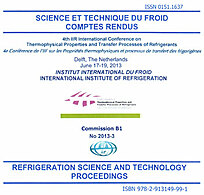
Résumé
This paper experimentally compares the heat transfer performance of four different shell-and-tube gas coolers implemented in a R744 water/water heat pump (5 kW heating power,0¡C evaporation temperature, 10MPagas cooler pressure, 35 ¡C gas cooler outlet temperature) controlled by a back pressure valve as expansion device. The tubes bundle consists of 10 tubes in a 30¡ arrangements for all the gas coolers, which use different tube geometries: smooth, corrugated, internally grooved and corrugated and internally grooved tubes, respectively. The experimental results are carried out at fixed gas cooler inlet water temperature (25¡C) and by imposing two inlet gas cooling pressures of 8 MPa and 10 MPa. The water flow rate is varied between 160 and 700 l h-1in order to study the shell side heat transfer performance. On the basis of the experimental measurements, the heat transfer performance of the four shell-and-tubes gas coolers are compared in terms of overall heat transfer coefficient. Furthermore, a step-by-step procedure for the simulation of the heat transfer cooling process of the carbon dioxide in shell and tubes gas coolers is proposed and validated against the experimental results.
Documents disponibles
Format PDF
Pages : 8 p.
Disponible
Prix public
20 €
Prix membre*
Gratuit
* meilleur tarif applicable selon le type d'adhésion (voir le détail des avantages des adhésions individuelles et collectives)
Détails
- Titre original : Shell and tube gas coolers for carbon dioxide heat pump applications.
- Identifiant de la fiche : 30008275
- Langues : Anglais
- Source : 4th IIR Conference on Thermophysical Properties and Transfer Processes of Refrigerants
- Date d'édition : 17/06/2013
Liens
Voir d'autres communications du même compte rendu (69)
Voir le compte rendu de la conférence
-
System optimization of CO2 heat pump water heat...
- Auteurs : ZHANG F. Z., JIANG P. X., ZHU Y. H., et al.
- Date : 02/08/2014
- Langues : Anglais
- Source : 11th IIR Gustav Lorentzen Conference on Natural Refrigerants (GL2014). Proceedings. Hangzhou, China, August 31-September 2, 2014.
- Formats : PDF
Voir la fiche
-
The effect of inner grooved tubes on the heat t...
- Auteurs : KAJI R., YOSHIOKA S., FUJINO H.
- Date : 16/07/2012
- Langues : Anglais
- Source : 2012 Purdue Conferences. 14th International Refrigeration and Air-Conditioning Conference at Purdue.
- Formats : PDF
Voir la fiche
-
Efficiency improvement of a high capacity trans...
- Auteurs : NESREDDINE H., MONNEY D., WEHBER W.
- Date : 15/05/2023
- Langues : Anglais
- Source : 14th IEA Heat Pump Conference 2023, Chicago, Illinois.
- Formats : PDF
Voir la fiche
-
Compact brazed plate heat exchangers for CO2 he...
- Auteurs : LEIGHTON D., HWANG Y., RADERMACHER R.
- Date : 12/04/2010
- Langues : Anglais
- Source : 9th IIR-Gustav Lorentzen Conference on Natural Working Fluids (GL2010). Proceedings. Sydney, Australia, April 12-14, 2010.
- Formats : PDF
Voir la fiche
-
Ground mass temperature analysis with the slink...
- Auteurs : ADAMOVSKÝ R., NEUBERGER P., MAŠEK L., et al.
- Date : 16/06/2013
- Langues : Anglais
- Source : Clima 2013. 11th REHVA World Congress and 8th International Conference on Indoor Air Quality, Ventilation and Energy Conservation in Buildings.
- Formats : PDF
Voir la fiche
